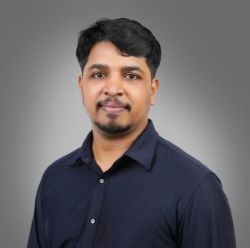
All India Rubber Industries Association conducted webinar on 5 August 2025, under their Knowledge Series: Rubber & Beyond on topic Reverse Engineering of Rubber Products by speaker Dr. Harikrishnan Pulikkalparambil. Currently, he is an Assistant Professor at the School of Nanoscience and Nanotechnology, Mahatma Gandhi University (MGU), Kerala, India.
He has made notable contributions to the scientific community with over 50 publications in high-quality international peer-reviewed journals, as well as contributions in editorial corners, book chapters, and authored books. Additionally, he has applied for 3 Thailand patents, one of which was awarded in 2023. Dr. Harikrishnan won the "Best Paper Award-Scientist" in Engineering and Technology at the 34th Kerala Science Congress held in 2022 granted by the Kerala State Council for Science, Technology, and Environment (KSCSTE), Government body in Kerala, India.
His research interests are wide ranging and cover diverse areas, including the preparation and characterization of self-healing coatings, biopolymers, polymer composites, blends, novel fibers, food packaging materials, and recycling of polymers.
The webinar started with the active participation from more than 160 participations. Dr. Harikrishnan Pulikkalparambil started with a comprehensive presentation on reverse engineering in the rubber industry and discussed the concepts of forward and reverse engineering in the context of rubber products. He explained that forward engineering involves creating a product from scratch based on specific requirements, while reverse engineering involves deconstructing an existing product to analyze its composition and performance.
The importance of reverse engineering in reducing time and resources needed for product development, enabling faster product launches and providing a competitive advantage by aligning with market best practices. He touched on the traditional process of formula construction in the rubber industry, noting two common situations faced by compounders: designing a formula without specifications and designing a compound based on existing specifications.
The process of designing a truck bus radial tire compound, detailing the selection of elastomers, fillers, oils, vulcanizing agents, accelerators, and antioxidants based on specific performance requirements and cost considerations. The importance of balancing cost and performance, providing a method to calculate the cost of a compound by considering the specific gravity, weight, and cost per kilogram of each ingredient.
Talking about analytical techniques for material analysis, he explained various analytical techniques used to analyze materials, including thermal methods like TGA, DSC, and TMA, spectroscopy, and chromatography. He detailed how these techniques can identify properties such as degradation temperature, weight percentage of compounds, glass transition temperature, functional groups, and metallic impurities.
Harikrishnan also discussed alternative methods for analyzing black materials, suggesting X-ray diffraction and various chromatographic techniques.
The session concluded with a case study and discussion of competitive advantages in the industry, followed by questions about cost and identification methods, with Harikrishnan agreeing to share additional resources with interested participants.